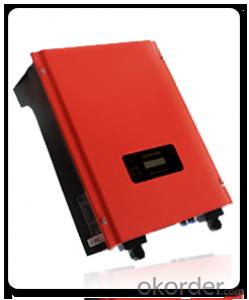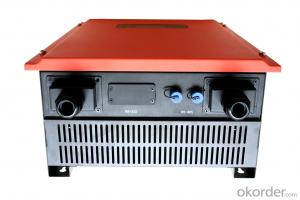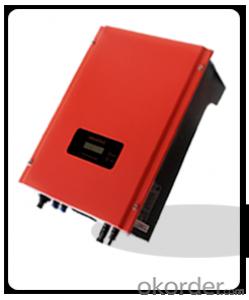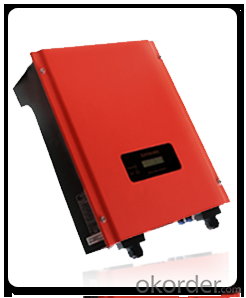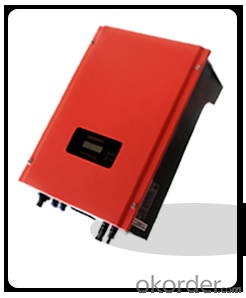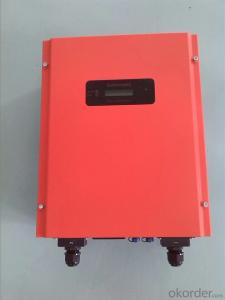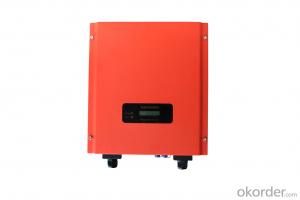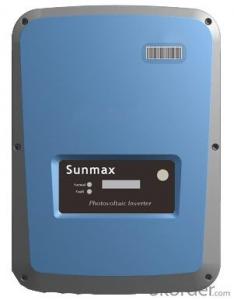Fusion Solar Inverter Sunteams 3600-5000 PV
- Loading Port:
- Shanghai
- Payment Terms:
- TT OR LC
- Min Order Qty:
- 5 watt
- Supply Capability:
- 3000 watt/month
OKorder Service Pledge
OKorder Financial Service
You Might Also Like
The Sunteams 1500 ~5000 series is applicable to various rooftops and small scale photovoltaic grid-connected power plants. Their nominal output powers are 1.5 kW, 2 kW, 2.5 kW,
3 kW, 3.6 kW, 4 kW and 5kW respectively.
This series is transformerless and has a wide range of MPPT input voltage. Its maximum conversion efficiency and MPPT tracking accuracy reach 97.6 % and 99.5 % respectively. The maximum DC voltage reaches 550 V. Its multilingual LCD display facilitates easy operation. It has waterproof direct plug-in terminals. It has overvoltage, islanding, short-circuit, overloading and overheating protection functions. Its IP65 protection degree will ensure it runs well in various tough environments
Efficient
■ The maximum efficiency of the inverter can reach 96.5 % - 97.6 %
■ Transformerless design
Flexible
■ For indoor and outdoor installation
■ Maintenance free
Simple
■ ‘Plug and play’connection for easy installation
■ Designed for hanging with simple and easy installation
Communicative
■ RS232 / RS485 interfaces as standard
■ Optional Bluetooth technology
- Q: Can a solar inverter be used in areas with unstable power grids?
- Yes, a solar inverter can be used in areas with unstable power grids. Solar inverters are designed to convert the direct current (DC) generated by solar panels into alternating current (AC) suitable for use in homes or businesses. In areas with unstable power grids, where there are frequent power outages or voltage fluctuations, solar inverters can provide a reliable source of electricity by switching to battery power during grid failures or regulating the voltage to protect sensitive equipment. Additionally, some advanced solar inverters have features like grid support functions or anti-islanding protection, which allow them to operate safely and effectively even in areas with unstable power grids.
- Q: Can a solar inverter be used in areas with frequent power outages?
- Yes, a solar inverter can be used in areas with frequent power outages. Solar inverters are designed to convert the direct current (DC) electricity generated by solar panels into alternating current (AC) electricity that can be used to power household appliances and electronics. In the event of a power outage, a solar inverter can continue to supply electricity to the connected loads, provided that the solar panels are receiving sunlight. However, it is important to note that a solar inverter alone may not provide a constant power supply during extended power outages unless it is paired with a battery storage system.
- Q: Can a solar inverter be integrated with a smart home system?
- Yes, a solar inverter can be integrated with a smart home system. By connecting the solar inverter to the smart home system, users can monitor and control their solar energy production and consumption remotely. This integration allows for better energy management, optimizing the use of solar power, and potentially saving on electricity bills.
- Q: Can a solar inverter be used with a solar air conditioning system?
- Yes, a solar inverter can be used with a solar air conditioning system. A solar inverter is responsible for converting the direct current (DC) power generated by solar panels into alternating current (AC) power that can be used to operate electrical appliances. Solar air conditioning systems typically require AC power to function, so a solar inverter would be necessary to convert the DC power from the solar panels into the AC power needed for the air conditioning system.
- Q: Can a solar inverter be used with different types of grid support functions?
- Yes, a solar inverter can be used with different types of grid support functions. Solar inverters are designed to convert the direct current (DC) produced by solar panels into alternating current (AC) that can be fed into the electrical grid. They can be equipped with various grid support functions like reactive power control, voltage regulation, and frequency control. These functions enable solar inverters to adapt to different grid requirements and contribute to grid stability and reliability.
- Q: Can a solar inverter be used with a remote control system?
- Yes, a solar inverter can be used with a remote control system. Many modern solar inverters come equipped with built-in communication interfaces that allow for remote monitoring, control, and adjustment of the inverter's settings. This can be done through a dedicated software or mobile application, allowing users to conveniently manage their solar energy system from a remote location.
- Q: Can a solar inverter be used off-grid?
- Yes, a solar inverter can be used off-grid. Off-grid systems typically include a solar panel array, a charge controller, batteries for energy storage, and an inverter to convert the stored DC (direct current) electricity from the batteries into AC (alternating current) electricity for use in off-grid applications. The inverter plays a crucial role in converting the DC power from the solar panels or batteries into usable AC power, making it possible to power various appliances and devices off-grid using solar energy.
- Q: Can a solar inverter be used with solar concentrators?
- Yes, a solar inverter can be used with solar concentrators. Solar concentrators focus sunlight onto a smaller area, increasing the intensity of the light. The solar inverter's primary function is to convert the DC power generated by the solar panels into AC power suitable for use in homes or businesses. Therefore, it can still be used to convert the enhanced DC power generated by solar concentrators into usable AC power.
- Q: How does MPPT improve the efficiency of a solar inverter?
- MPPT (Maximum Power Point Tracking) improves the efficiency of a solar inverter by continuously adjusting the operating point of the solar panels to ensure they are producing maximum power. This is achieved by maximizing the voltage and current output of the panels, which allows the inverter to convert more of the available solar energy into usable electricity. By constantly tracking the maximum power point, MPPT ensures that the solar inverter operates at its highest efficiency, resulting in increased overall system efficiency and improved energy generation.
- Q: Can a solar inverter be used with a three-phase electrical system?
- Yes, a solar inverter can be used with a three-phase electrical system. In fact, many solar inverters are designed to work with three-phase systems. These inverters are capable of converting the direct current (DC) generated by the solar panels into alternating current (AC) that can be used by the three-phase electrical system.
Send your message to us
Fusion Solar Inverter Sunteams 3600-5000 PV
- Loading Port:
- Shanghai
- Payment Terms:
- TT OR LC
- Min Order Qty:
- 5 watt
- Supply Capability:
- 3000 watt/month
OKorder Service Pledge
OKorder Financial Service
Similar products
Hot products
Hot Searches
Related keywords
